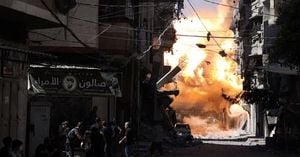On August 25, 2025, a series of Israeli strikes on Nasser Hospital in Gaza left 22 people dead, including five journalists, and ignited a storm of controversy about the rationale and execution of the attack. The Associated Press (AP) has since conducted a thorough investigation, raising serious questions about the Israeli military’s justification for the operation and its method of carrying it out.
The attack, which unfolded in four separate strikes without warning, targeted one of the last functioning hospitals in Gaza—a site that had become a crucial hub for Palestinian journalists and medical workers alike. Among those killed were AP contributor Mariam Dagga and Reuters video journalist Hussam al-Masri. According to AP reporting, Israeli forces struck a position widely recognized as a gathering point for journalists. The Israeli military claimed their target was a camera they believed Hamas was using to monitor troop movements, citing “suspicious behavior” and noting that the camera was draped with a towel, which they interpreted as an attempt at concealment.
Yet, as AP’s investigation uncovered, the camera belonged to al-Masri, who had a well-documented habit of covering his equipment with a white cloth to shield it from the relentless sun and dust—a common practice among video journalists worldwide, especially in harsh climates like Gaza. Dagga herself had photographed al-Masri with his camera and the white cloth just weeks before the attack. Colleagues and hospital officials confirmed that al-Masri had been broadcasting live from the hospital’s external stairwell almost daily in the weeks leading up to the strike. The hospital stairwell, with its elevated vantage point, was a lifeline for news agencies like Reuters and AP, providing live video feeds to global audiences and a rare, reliable Wi-Fi signal for transmitting crucial updates from the heart of Khan Younis.
Witnesses and video evidence suggest that Israeli forces had ample opportunity to correctly identify al-Masri and his equipment. According to AP, Israeli drones had observed the position just 40 minutes before the first strike. Despite this, the attack went ahead, killing both al-Masri and another person whose identity remains uncertain due to the chaotic aftermath.
The strikes did not end there. Within minutes of the first explosion, as medics, emergency workers, and journalists rushed to aid the wounded, Israeli forces struck the same position again. This so-called “double tap” attack—where a second strike targets rescuers responding to the initial blast—has been condemned by international law experts as a possible war crime. Raed al-Nims, head of the Palestinian Red Crescent’s media department in Gaza, told AP that such double tap strikes have “happened multiple times” during the conflict, often hitting ambulances and personnel after they arrive at scenes of devastation.
Among those killed in the second round of strikes were Mariam Dagga and Moaz Abu Taha, another journalist. Dagga’s brother, Sediq, recounted the harrowing moments after the attack: “I rushed upstairs and recovered her body,” he said. The AP’s analysis, based on interviews with nearly 20 people present at the hospital, found no evidence that anyone killed in the strikes was armed or engaged in hostilities.
Adding to the controversy is the Israeli military’s choice of weaponry. Instead of using more precise guided munitions, troops fired high-explosive tank shells at the hospital—a decision that weapons analysts say likely contributed to the high casualty count. AP reviewed photos of shrapnel from the scene and confirmed, with the help of munitions expert N.R. Jenzen-Jones, that the remnants were consistent with tank shells used by Israel. Satellite imagery from the day of the attack showed Israeli tanks and armored vehicles operating about 4.5 kilometers northeast of the hospital. An official with knowledge of the operation admitted to AP that the tank was not supposed to have been used, though they could not clarify what the original plan had been.
The brigade responsible, the Golani Brigade, was also involved in a deadly incident in March 2025, when Israeli forces shot at an ambulance convoy in southern Gaza, killing 15 Palestinian medics. An internal investigation into that attack found a “chain of professional failures” and led to the dismissal of a deputy commander.
Following the Nasser Hospital strikes, Israeli officials released the names of six men they claimed were militants killed in the attack. However, AP’s review of hospital records revealed discrepancies. One named individual, Omar Kamel Shahada Abu Teim, was not listed among the casualties, and doctors could not confirm his death. Another, Jumaa al-Najjar, was a healthcare worker, and a third, Imad al-Shaer, was a driver for Gaza’s Civil Defense. The remaining three names matched the casualty list, but details about their roles were unclear. Israel did not specify whether any were killed in the initial strike or as part of the crowd that gathered afterward.
The Israeli military has not provided evidence to support its claims and has acknowledged “gaps” in how the attack was carried out. Prime Minister Benjamin Netanyahu described the event as a “tragic mishap” but stopped short of offering a formal apology. The military says it is still investigating, but has refused to comment on whether the wrong people were targeted or if protocols were breached.
The incident has drawn sharp criticism from press freedom advocates and humanitarian organizations. Jody Ginsberg, CEO of the Committee to Protect Journalists, stated unequivocally, “Journalists are civilians and must never be targeted in a war. To do so is a war crime.” The Committee to Protect Journalists reports that 189 Palestinian reporters have been killed by Israeli fire in Gaza since the war began in October 2023. With foreign journalists barred from entering Gaza, local Palestinian reporters have become an essential—if perilous—lifeline for news from the besieged territory.
In a joint letter, AP and Reuters expressed outrage and demanded answers from the Israeli military: “Unfortunately, we have found the (Israeli military’s) willingness and ability to investigate itself in past incidents to rarely result in clarity and action, raising serious questions including whether Israel is deliberately targeting live feeds in order to suppress information.”
Israel maintains that it does not intentionally target journalists or hospitals, blaming civilian casualties on Hamas for operating in densely populated areas and sometimes within medical facilities. While international law does allow for the loss of protected status if hospitals or journalists are directly participating in hostilities, AP’s investigation found no evidence that those killed in the hospital strikes were armed or acting as combatants.
As Israeli forces continue their offensive in famine-stricken Gaza City, the world watches closely, demanding accountability and answers for the events at Nasser Hospital—a tragedy that has only intensified global scrutiny of Israel’s conduct in the ongoing conflict.




